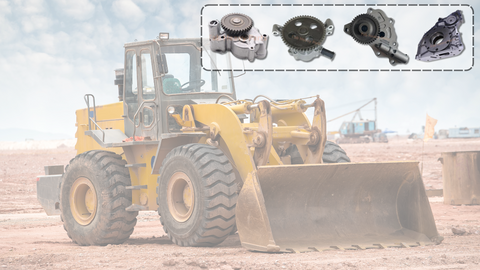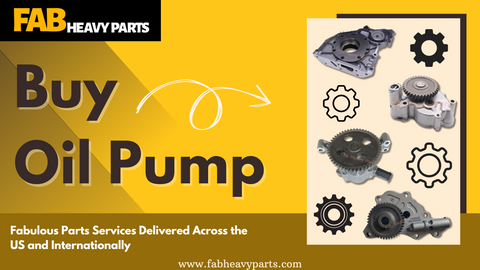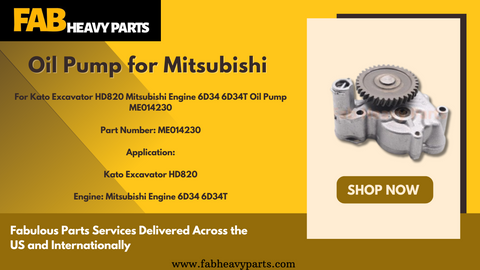
The essential function of an oil pump is to deliver engine oil with precision to a range of critical motor components, such as the camshaft, pistons, and bearings. By supplying lubrication to these pivotal parts, the oil effectively minimises friction among the moving elements. Moreover, the oil plays a crucial role in preventing the engine from seizing, ensuring optimal performance and longevity.
Oil Pump Fundamentals:
The oil pump is a critical component responsible for delivering lubricating fluid throughout the intricate passages and galleries of the engine. Positioned either inside the oil pan, where it is driven by the camshaft, or outside the pan with the crankshaft powering it, the oil pump plays a vital role in maintaining the engine's health and performance.
Oil is drawn from the pan and passes through a filter designed to eliminate debris before entering the pump. Once inside the pump, the fluid is pressurised to facilitate its movement through the engine's various passageways, ensuring optimal lubrication of essential components.
There are two primary designs of oil pumps commonly used in engines:
- Gear Pump: This type of oil pump features two gears that work in tandem to create suction. As these gears rotate, oil is drawn through the inlet into the pump. Subsequently, the pressurised oil is expelled through the outlet, ready to lubricate the engine's moving parts.
- Rotor Pump: The rotor pump utilises both an inner and outer rotor. The lobes of these rotors rotate to draw oil through the inlet and then push it out through the outlet as a pressurised fluid, ready to fulfil its lubricating duties within the engine.
To maintain the proper functioning of the oil pump and prevent excessive pressure build-up, an oil pressure relief valve is typically installed at the pump's outlet. This valve ensures that the oil pressure remains within the recommended range, which typically falls between 10 and 80 psi, although this range may vary depending on the specific design of the engine.
Signs of a Faulty Oil Pump
An oil pump can cease to function properly either due to mechanical breakdown or insufficient fluid levels. In a matter of minutes, the engine can cease to operate as a result of diminished oil pressure. Here are several indicators to be mindful of:
- Dashboard Warning Lights: The oil pressure warning light may illuminate when engine sensors detect a significant drop in oil pressure. This issue could also trigger the activation of the check engine light.
- Decreased Oil Pressure: A failing pump is unable to adequately pressurise the oil. In the absence of sufficient pressure, essential engine components such as the crankshaft, camshaft, and bearings may be deprived of vital lubrication.
- Unusual Engine Noise: Insufficient oil supply to the engine can lead to the emergence of abnormal sounds. Ticking, tapping, rattling, or knocking noises may be audible, depending on the severity of the situation. It is imperative to address these noises promptly.
- Engine Failure to Start: Insufficient oil pressure may prevent the engine from starting. Some vehicles are designed to halt fuel delivery automatically in the event of inadequate oil pressure to safeguard the engine from damage.
How to Replace an Oil Pump
Embarking on the journey of replacing an oil pump demands a profound understanding of mechanical intricacies. This task transcends the routine maintenance typically handled by the amateur home mechanic. Should you possess the advanced knowledge requisite for this undertaking, here is a detailed elucidation of the steps involved in a typical oil pump replacement:
- Commence by disconnecting the negative battery terminal to ensure safety during the procedure.
- Employ your trusty floor jack to elevate the front of the vehicle, subsequently securing it on jack stands for stability.
- Proceed to drain the oil from the engine to prepare for the replacement process.
- Remove the serpentine belt to gain access to the oil pump.
- Unfasten the oil pan bolts and carefully remove the oil pan from its position.
- Delve into the task of removing the bolts that secure the oil pump to the crankcase or block.
- While firmly grasping the oil pump driven by the crankshaft, manoeuvre the tensioner to create slack in the timing chain, thereby facilitating the removal of the pump.
- Thoroughly cleanse the surfaces using brake cleaner to ensure optimal performance. - Install the new oil pump meticulously, tightening the bolts to the specified factory torque settings.
- Reattach the timing chain to the pump driven by the crankshaft with precision. - Secure the oil pan in place by hand-tightening the bolts attentively.
- Refill the engine with the appropriate quantity of oil to restore its functionality. - Lower the vehicle back to the ground cautiously. Initiate the engine and allow it to run briefly, keenly listening for any unusual sounds. Subsequently, inspect for leaks and verify the oil level before embarking on your journey.
The financial aspect of this endeavour warrants consideration, with the cost of replacing an oil pump typically ranging between $100 and $450 for a DIY project. However, this cost may vary depending on the vehicle type. Opting for a professional mechanic to undertake the oil pump replacement may escalate the expenditure to a range of $450 to $1,500.
Oil Pump Maintenance
Ensuring the longevity and optimal performance of your oil pump is paramount in maintaining the overall health of your vehicle. By adhering to a consistent regimen of car maintenance, you can significantly prolong the life expectancy of your oil pump. Here are some indispensable tips to uphold the pristine condition of your oil pump:
- Engage in regular oil changes to prevent the accumulation of debris within the pump, thereby facilitating smooth operation and efficiency.
- Regularly replace the oil filter to ensure that the oil circulating in the system remains clean and free of contaminants that could potentially compromise the pump's functionality.
- Vigilantly monitor the oil pressure gauge and promptly cease driving if the pressure falls below the normal parameters, as this could indicate a potential issue with the pump that needs immediate attention.
- Keep a watchful eye out for any signs of oil leaks, as these can not only lead to a loss of oil but also result in severe engine damage if left unaddressed. Swiftly rectify any leaks as soon as they are detected to prevent any further complications.
By diligently following these guidelines, you can effectively safeguard the health and performance of your oil pump, contributing to the overall reliability and longevity of your vehicle.
Popular Oil Pump
1. Oil Pump for Mitsubishi
For Kato Excavator HD820 Mitsubishi Engine 6D34 6D34T Oil Pump ME014230
Part Number: ME014230
Application:
Kato Excavator HD820
Engine: Mitsubishi Engine 6D34 6D34T
Enhance the performance of your Kato Excavator HD820 with the top-of-the-line Mitsubishi Engine 6D34 6D34T Oil Pump ME014230. This high-quality oil pump is designed to deliver optimal lubrication to your engine, ensuring smooth operation and maximum efficiency.
2. Oil Pump for Kobelco
Kobelco Excavator SK330-6E SK320-6 SK350-6 Mitsubishi Engine 6D16 Oil Pump ME074345
Condition: new, aftermarket
Part number: ME074345
Engine fitment: 6D16 Mitsubishi
Application: SK330-6E SK320-6 SK350-6
Discover the high-performance Kobelco Excavator SK330-6E, SK320-6, and SK350-6 fitted with the reliable Mitsubishi Engine 6D16 Oil Pump, part number ME074345. This precision-engineered oil pump is designed to ensure optimal lubrication for your excavator's engine, enhancing its longevity and efficiency.
3. Oil Pump for John Deere
Oil Pump 8981451531 Fits for John Deere Excavator 135D 135G Isuzu 4JJ1 Engine
Condition: new, aftermarket
Part Number: 8981451531
Fits for John Deere Excavator 135D 135G Isuzu 4JJ1 Engine
Enhance the performance of your John Deere Excavator 135D and 135G with the Oil Pump 8981451531 designed specifically for the Isuzu 4JJ1 engine. This precision-engineered oil pump ensures optimal lubrication, enhancing the efficiency and longevity of your equipment.
4. Oil Pump for Deutz
For Deutz Engine BF6M2012 Oil Pump 04258382
Condition: new, aftermarket
Part NO.: 04258382, 4258382
Application:
Engine: Deutz BF6M2012, TCD2012 2V
Explore peak performance with the Deutz Engine BF6M2012 Oil Pump 04258382. Elevate your machinery to new heights with this essential component designed to ensure optimal lubrication and efficiency.
FAB Heavy Parts Can Help With Your Needs
Welcome to Fab Heavy Parts' online catalog, where you can explore a delightful array of oil pump. We have a diverse selection to cater to your needs. Our knowledgeable parts team is at your disposal, ready to assist you every step of the way.












